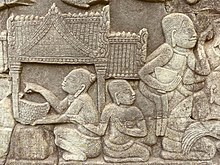
Khmer architecture, also known as Angkorian architecture, is the architecture produced by the Khmers during the Angkor period of the Khmer Empire from approximately the later half of the 8th century CE to the first half of the 15th century CE.

Angkor, also known as Yasodharapura, was the capital city of the Khmer Empire. The city and empire flourished from approximately the 9th to the 15th centuries. The city houses the Angkor Wat, one of Cambodia's most popular tourist attractions.
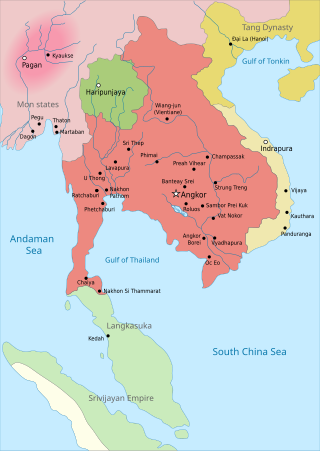
The Khmer Empire was a Hindu-Buddhist empire in Southeast Asia, centered around hydraulic cities in what is now northern Cambodia. Known as Kambuja by its inhabitants, it grew out of the former civilisation of Chenla and lasted from 802 to 1431. Historians call this period of Cambodian history the Angkor period, after the empire's most well-known capital, Angkor. The Khmer Empire ruled or vassalised most of mainland Southeast Asia and stretched as far north as southern China. At its peak, the Empire was larger than the Byzantine Empire, which existed around the same time.
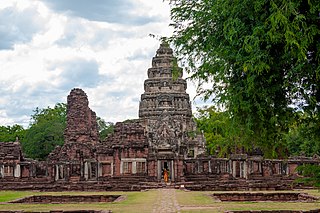
The Phimai Historical Park is a historical park in Thailand, covering the ancient town of Phimai and the ruins of Prasat Phimai Thai: ปราสาทพิมาย, pronounced[prāː.sàːtpʰí(ʔ).māːj]) the largest ancient Khmer-Hindu temple in Thailand. It is located in the town of Phimai, Nakhon Ratchasima province. It is one of the most important tourist attractions in the province.
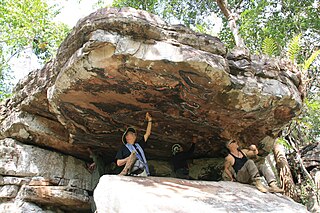
The early history of Cambodia follows the prehistoric and protohistoric development of Cambodia as a country in mainland Southeast Asia. Thanks to archaeological work carried out since 2009 this can now be traced back to the Neolithic period. As excavation sites have become more numerous and modern dating methods are applied, settlement traces of all stages of human civil development from neolithic hunter-gatherer groups to organized preliterate societies are documented in the region.

Banteay Kdei, also known as "Citadel of Monks' cells", is a Buddhist temple in Angkor, Cambodia. It is located southeast of Ta Prohm and east of Angkor Thom. Built in the mid-12th to early 13th centuries AD during the reign of Jayavarman VII, it is in the Bayon architectural style, similar in plan to Ta Prohm and Preah Khan, but less complex and smaller. Its structures are contained within two successive enclosure walls, and consist of two concentric galleries from which emerge towers, preceded to the east by a cloister.
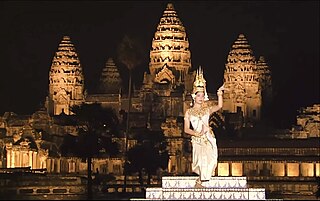
Throughout Cambodia's long history, religion has been a major source of cultural inspiration. Over nearly two millennia, Cambodians have developed a unique Cambodian culture and belief system from the syncreticism of indigenous animistic beliefs and the Indian religions of Buddhism and Hinduism. Cambodia's unparalleled achievements in art, architectures, music, and dance from the 9th and 14th century have had a great influence on many neighboring kingdoms, namely Thailand and Laos. The effect of Khmer culture can still be seen today in those countries, as they share many close characteristics with current-day Cambodia.

The Pinpeat is the largest Khmer traditional musical ensemble. It has performed the ceremonial music of the royal courts and temples of Cambodia since ancient times. The orchestra consists of approximately nine or ten instruments, mainly wind and percussion. It accompanies court dances, masked plays, shadow plays, and religious ceremonies. This ensemble is originated in Cambodia since before Angkorian era.

Koh Ker is a remote archaeological site in northern Cambodia about 120 kilometres (75 mi) away from Siem Reap and the ancient site of Angkor. It is a jungle filled region that is sparsely populated. More than 180 sanctuaries were found in a protected area of 81 square kilometres (31 sq mi). Only about two dozen monuments can be visited by tourists because most of the sanctuaries are hidden in the forest and the whole area is not fully demined.

The history of 'art stretches back centuries to ancient times, but the most famous period is undoubtedly the Khmer art of the Khmer Empire (802–1431), especially in the area around Angkor and the 12th-century temple-complex of Angkor Wat, initially Hindu and subsequently Buddhist. After the collapse of the empire, these and other sites were abandoned and overgrown, allowing much of the era's stone carving and architecture to survive to the present day. Traditional Cambodian arts and crafts include textiles, non-textile weaving, silversmithing, stone carving, lacquerware, ceramics, wat murals, and kite-making.

Khmer traditional clothing refers to the traditional styles of dress worn by the Khmer people throughout history. Tracing their origins back to the early Common Era, the customary styles of dress worn by Khmer people predate the indianization of Southeast Asia. The evolution of these clothing customs can be traced through archaeological artifacts from the 6th century to the post-Angkorian period, evolving from the simple pre-Angkorian Sampot to vibrant and intricately embroidered silk garments. Khmer traditional costumes are nowadays mainly worn for celebrations, reflecting a strong sense of national identity.

The Roneat Ek or Roneat Aek is a xylophone used in the Khmer classical music of Cambodia. It is built in the shape of a curved, rectangular shaped boat. It has twenty-one thick bamboo or hard wood bars that are suspended from strings attached to the two walls. They are cut into pieces of the same width, but of different lengths and thickness. Originally these instruments were highly decorated with inlay and carvings on the sides of the sound box. Now they are simpler. The Roneat is played in the Pinpeat ensemble. In that ensemble, sits on the right of the Roneat Thung, a lower-pitched xylophone. The roneat ek is the analogous equivalent to the Thai xylophone called ranat ek, and the Burmese bamboo xylophone called "pattala".

The roneat dek is a Cambodian metallophone, comparable to the Roneat ek. It is an ancient instrument made of 21 blackened-iron bars. It may be used in the Pinpeat ensemble and Mahaori orchestra. It is believed to have originated from the Royal Courts before the Angkor period. This instrument is rarely covered with ornamentation on either the bars or the sound box. The roneat dek is analogous to the ranat ek lek of Thailand.

Sompot Chong Kben is a Cambodian unisex, lower body, wraparound cloth. It was adopted in the neighbouring countries of Laos, and Thailand, where it is known respectfully as pha hang (ຜ້າຫາງ) and chong kraben. It was the preferred choice of clothing for women of upper and middle classes for daily wear. Unlike the typical sompot, it is more of a pant than a skirt. The chong kraben is described by art historian Eksuda Singhalampong as "...a garment that resembles loose breeches. The wearer wraps a rectangular piece of cloth around his [or her] waist, the edge of cloth is then passed between the legs and tucked in at the wearer's lower back. Many 19th-century European accounts often called them knee breeches, riding breeches or knickerbockers."

Sbai or phaa biang is a shawl-like garment worn by women in Cambodia, Laos, and Thailand to cover the breasts, while in Sumatra, Borneo and the Malay Peninsula, the same term is used to describe a cloth hanging from the shoulders. The sbai was derived from the Indian sari, the end of which is worn over one shoulder.
A Dharmasala or a house of fire, or house with fire, is the name given to a place where people, especially pilgrims, can rest on a journey. It is a type of building found in Angkorian complexes constructed during the reign of late 12th-century monarch Jayavarman VII and still found in Preah Khan, Ta Prohm and Banteay Chhmar.

Roneat is the generic Khmer word for referring to several types of xylophones used in traditional Cambodian music; the pinpeat and mohaori.
Traditional Cambodian medicine comprise several traditional medicine systems in Cambodia.

Mohaori is one of the traditional musical ensembles of Cambodia. This traditional ensemble is known in full name as Vung Phleng Mohaori (វង់ភ្លេងមហោរី), literally means Mohaori Musical Ensemble. It composed of many kinds of musical instruments, but today it is more specifically applied to a small ensemble of wind, stringed, and percussion musical instruments.

Robam Kenorei or Robam Kenor is one of Cambodian traditional dance depicting a group of benevolent half-human, half-bird creatures dancing in a lotus pond that frequently performed in the Royal Ballet of Cambodia.


